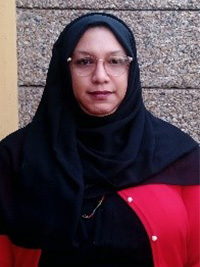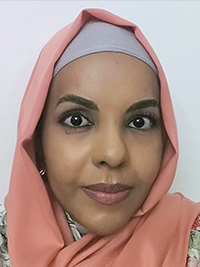
Athi Baliso
Title: A non-metric and geometric morphometric assessment of the variation in the bony pelvis of South Africans of Mixed Ancestry.
Supervisor: Prof Victoria Gibbon
Collaborators: Dr Philipp Gunz and Dr Alexandra Schuh (MPI)
Accurately estimating sex and age-at-death is crucial to generating a biological profile for the identification of unknown persons, by reducing the number of potential matches. Despite many years of development and refinement of sex and age-at-death standards, obtaining accurate classifications remains challenging due to variations within and between populations. The bony pelvis (os coxae and sacrum) is the most reliable skeletal indicator of sex and age-at-death. However, the utility of the bony pelvis as a marker for sex and age has had limited investigation in South Africans of Mixed Ancestry (SAMA), and the performance of existing standards for sex and age in this population is largely unknown. Furthermore, there is a lack of population-specific sex and age estimation standards for SAMA. SAMA exhibit distinct global traits due to complex admixture, notably from the Holocene San and Khoekhoe groups. Previous research has found that while Holocene San and Khoekhoe populations exhibit sexual dimorphism, albeit with lower accuracy compared to other populations. It has been observed through forensic casework that existing standards tend to be inaccurate when applied to SAMA.
Thus, this study aims to characterize variation in sex and age related pelvic traits, assess the accuracy of sex and age-at-death classifications and developing population-specific standards for SAMA. This will be an observational and cross-sectional study, involving the collection and analysis of original sex and age data from the bony pelves of an adult contemporary population of SAMA utilising non-metric and 3D geometric morphometric techniques.
This study will use geometric morphometric assessments to quantify and visualize the pelvic shape for SAMA. In addition, the accuracies of the Klales et al. (2012) sexing method along with three age-at-death methods, namely the Brooks and Suchey (1990), Buckberry and Chamberlain (2002) and Rissech et al. 2006 will be tested. Thereafter, population-specific sex and age-at-death standards based on the non-metric and geometric morphometric assessments will be generated for SAMA. These data will improve our understanding of pelvic sex and age related expression, as well as sex and age classification accuracies in this population all while generating population specific standards to achieve accurate and precise classifications.
Contact details: E mail

Firzana Firfirey
Degree: PhD. Physiology
Thesis: The relationship between genes associated with the pain pathway and the development of chronic shoulder pain and disability in South African breast cancer survivors.
Registered: Dept. Human Biology
Supervisor: A/Prof Delva Shamley
Co-Supervisor/s: Prof. Alison September (HPALS)
Thesis description: Chronic pain and disability of the upper limb are documented side effects of treatment for breast cancer that may occur for up to 6 years after treatment completion. Opioids are clinically prescribed to manage acute and chronic pain, including morphine, fentanyl, tramadol, and others. Despite receiving pain management roughly 40% of breast cancer survivors (BCS) suffer this side effect. Emerging studies surrounding survivorship has shown chronic pain can negatively impact various aspects of an individual’s life, including psychological and physical health, increased economic costs, and overall quality of life. Several known risk factors for chronic post-operative pain in BCS include surgical age; axillary lymph node dissection (ALND); adjuvant therapies, pre-operative and severe acute post- operative pain, and genetics.
Pharmacogenetic studies have implicated several genes within the opioid pathway that may contribute to an individual’s variable response to opioids. Single nucleotide polymorphisms (SNPs) are the most common form of genetic variations, and although most do not affect gene function, it is hypothesised that may predispose individuals to a condition or influence the pharmacokinetics and -dynamics of drugs. Polymorphisms for the ABCB1, OPRM1 and COMT genes have previously been implicated in acute and chronic pain conditions, with some SNPs shown to affect protein structure and function. Furthermore, given the complex aetiology of pain, it is hypothesised that multiple genes too may interact on various levels contributing to pain modulation.
Study participants are recruited from the Groote Schuur Tertiary Hospital (Western Cape), and using the self-reported questionnaire, Shoulder Pain And Disability Index (SPADI), pain and disability will be evaluated. The SPADI scores will be used in an genetic association study to explore the relationship between SNPs for the ABCB1, OPRM1 and COMT genes, and chronic shoulder pain and disability observed in South African BCS of mixed ancestry.
The study therefore aims to 1) Determine the frequency and distribution of SNPs for ABCB1, OPRM1 and COMT in the BCS cohort, 2) Examine inferred haplotypes for ABCB1, OPRM1 and COMT within the BCS cohort and 3) Investigate gene-gene interactions between the ABCB1, OPRM1 and COMT genes and pain and disability within the BCS cohort and 4) In addition, a pilot study will examine the relationship between the genes, pain and disability, and opioids prescribed to participants during the treatment period.
Contact details: Email
_______________________________________________________________________________
Demi Govender
Degree: PhD in Human Anatomy and Cell Biology
Title: The Effects of Ibogaine on Myelination in rats
Registered in: Department of Human Biology
Supervisor: Dr Tanya Calvey
Co-supervisors: Prof. Dirk Lang and Prof Dan Stein
Thesis Summary:
Ibogaine has shown early promise for treating opioid use disorders, traumatic brain injury and multiple sclerosis. White matter pathology is a characteristic of all these disorders. In my master’s research, we found that ibogaine is able to upregulate markers of myelination in rats. My PhD project will uncover the mechanisms behind ibogaine’s effects on myelination in the brain. We are looking at how remyelination is facilitated by transcription factors, opioid receptors and neurotrophic factors.

Paidamoyo Kachambwa
PhD, Division of Clinical Anatomy and Biological Anthropology (CABA)
Exploring factors contributing towards competencies of medical sciences laboratory technicians and recommendations for plausible improvement: A case study of a Scientific Innovation Laboratory based in a resource constraint setting.
Supervisor: A/Prof Delva Shamley (CABA)
Co-supervisors: Dr Elmi Badenhorst (Department of Health Sciences Education) Dr Amaal Abrahams (Division of Cell Biology)
Thesis description:
Research in Africa and on African data is booming, seeing an increase in the numbers of projects taken up. In fields that are constantly advancing and evolving, it is essential to diligently and reproducibly conduct research, this will sustainably build research capacity in Africa. In particular, in order to tackle complex and/or big collaborative projects. There are four main categories that impede growth of research capacity in Africa. I will focus on the educational barrier as it builds on the competency needed to create quality outputs that attract funding and business to resolve the other three categories. For an organization to produce quality outputs, it is important to ensure that there is competency, that is, the necessary knowledge is applied when designing and implementing solutions.
From literature, this is one of the gaps that I would like to fill, to better understand what are the underlying contributing factors that affect competencies compared to the majority of solutions created for issues perceived by employees to be affecting the advancement of their competencies. Further, the majority of the studies have been conducted in developed countries in organisations with a staple service. The resulting solutions are not replicable in a resource constraint setting for organisation that have the complexity of dealing with a constant change of scope in work that many multifaceted contract research organisations face.
I have decided to conduct a study to look into factors contributing towards developing competencies of technicians who are based in resource constraint setting. Technicians are key as they complete core functions in research that directly affects outcomes. I will use 3 educational theories to elucidate how adults in this environment learn. I will draw on Jack Mezirow’s Transformative learning theory to describe my own journey, Community of Practice to describe lessons learnt from the journal club I established and Knowles Adult learning theory to understand my participant’s learning processes. To better understand the complexity of my case study’s system and the different factors at play that affect the technicians, I will use systems theory, that is looking at the human system.

Bianca Kruger
Degree: PhD in Human Genetics
Title: Molecular profiling of breast cancer for markers of genetic susceptibility and tamoxifen treatment response
Registered in: Department of Pathology
Supervisor: Prof Collet Dandara
Co-supervisors: A/Prof Delva Shamley
Thesis description
As of 2020, breast cancer was the most common newly diagnosed cancer and the leading cause of cancer death in women worldwide. Breast cancer is also the most dominant cancer in African women. Even though breast cancer incidence is substantially lower in Africa than in more developed regions, fatality rates are among the highest here necessitating the need for improved breast cancer screening and treatment for Africans.
Tamoxifen is the standard endocrine therapy for treating oestrogen receptor-positive breast cancer and has been shown to successfully reduce breast cancer recurrence and mortality rates. Still, variability in patient response to tamoxifen treatment exists with up to half of patients experiencing a recurrence event. Genetic variability in the pharmacogenes encoding enzymes involved in the metabolism of tamoxifen has been linked to some of this observed interindividual variability in tamoxifen treatment. There is, however, a conspicuous absence of tamoxifen pharmacogenetics studies in populations of African descent and as a result, tamoxifen treatment for these populations remains inadequate.
Therefore, this study aims to characterise breast cancer at molecular level for markers of tamoxifen drug response in Africans. As a secondary objective, molecular profiles of breast cancer risk may also be explored. This project will assist in the development of pharmacogenomic-guided tests for tamoxifen treatment that can be utilized in conjunction with clinical information to reduce breast cancer recurrence and mortality in South Africa.
___________________________________________________________________________
Mbalentle Yolanda Madolo
PhD candidate in Anatomy

Research Title: A dissection and angiographic study on the anatomical variations of the arteria radicularis magna (artery of Adamkiewicz) – A South African perspective.
Supervisors: Dr Kentse Mpolokeng and Emeritus Professor Graham Louw

Sadiyah Malek
Thesis title: Assessing epiphyseal union in South African female children using Low Dose X-ray (LODOX) for age estimation.
Supervisors: Professor Victoria Gibbon and Dr Kavita Lakha (NPA)
Thesis description: Skeletal age, based on the stages of bone formation, is a measure of biological maturation. As age increases and skeletal maturation progresses, identifiable hard tissue changes take place that are characteristic to each stage of development. Rates of epiphyseal union of bones is commonly used to estimate skeletal age.
Biological age estimation of individuals using the skeleton is a diagnostic tool used widely in clinical practice, forensic anthropology, bioarchaeology and even sports research. Age estimation is one of the most important analyses for juveniles, as it is the only biological parameter that can be determined with any accuracy in sub-adults and, to a large degree, independently of other biological parameters.
Hand and wrist radiographs are frequently used to estimate age from bones. However, studies have shown that these methods are not applicable to South Africans as they tend to both over and underestimate age in younger children (0 - 13 years), and overestimate age in adolescents and young adults (17 - 22 years). Additionally, age estimation methods tend to be population-specific and influenced by secular trends, thus are not accurate when applied to populations that differ from those used in the initial method development studies.
Despite the need for population-specific data in age estimation methods, there currently is a lack of published studies and comprehensive data on the union of major joints in South African female children. This study aims to use Low Dose X-ray (LODOX) radiographs to re-formulate epiphyseal union standards, tailoring them specifically to South African female children, for clinical, forensic and bioarchaeological application.
Contact details: Email

Portia Mamonyowe Motsoeneng
Degree: Doctor of Philosophy
Title: Development and Piloting of an Upper limb Rehabilitation Pathway for Breast Cancer Survivors in the Western Cape
Registered in: Depart of Human Biology - Division of Clinical Anatomy and Biological Anthropology
Supervisor: A/Prof Delva Shamley
Co-supervisors: Dr Lucy Cunnama (Health Economist)
Thesis description
Breast cancer has become a global public health burden and is the second most diagnosed cancer amongst women. In 2018, approximately 18 million cancer cases were reported worldwide, and are projected to increase to 21.6 million cases by 2030. The mortality rate due to cancer is equally high, with approximately 9 million cancer-related deaths worldwide in 2018, 7.3% of which were from Africa.
Due to advanced screening and treatment modalities, breast cancer survival rates increased beyond five years in economically developed countries and certain economically developing countries which include South Africa. (1) Despite the increased survival rate and improved treatment modalities, Breast cancer survivors are at risk of developing a chronic upper limb debilitating condition, such as breast cancer related lymphoedema (BCRL).
There is a dearth of information on the incidence, prevalence, secondary prevention interventions by health practitioners and breast cancer survivors lived experience in South Africa.
The aim of this study is to firstly assess the current South African upper limb rehabilitation service provision and perspectives of these services, from health professionals and the end users who are breast cancer survivor with upper limb disorder. Secondly to determine the feasibility of implementing an upper limb rehabilitation care pathway at GSH and lastly, to understand the experience of using the new interventions and obtain constructive input for further development to inform large scale implementation.
The successful development and implementation of this study will contribute to:
1. Policy formulation for the management of upper limb impairment among breast cancer survivors.
2. The South African Breast Cancer Policy Guidelines.
3. Informing the development of the Cancer Survivorship Program
_______________________________________________________________________________
Sandile Ntuli

Degree: PhD clinical anatomy
Title: The relationship between HIV infection and recurrent stroke risk in South Africa
Supervisiors :Dr. Kentse Mpolokeng
Co supervised by Assoc. Prof Geney Gunston and Prof Graham Louw.
Thesis description: This cohort study involves the use of computed tomography angioplasty (CTA), magnetic resonance imaging (MRI), and patient records from Groote Schuur Hospital's Neurology and Cardiology divisions.
The study includes stroke patients that are HIV positive, compared with stroke patients without HIV. Measurements of cerebral artery diameters will be taken at multiple sites, including vertebral arteries (VA), basilar artery (BA), posterior cerebral artery (PCA), posterior communicating artery (PCoA), middle cerebral artery (MCA), anterior cerebral artery (ACA), and anterior communicating artery (ACoA).
Additionally, a systematic review of secondary stroke prevention (SSP) guidelines will be conducted to explore if there are any implementation challenges that could further contribute to stroke risk.
Aim: The goal is to improve our understanding of the dual burden of HIV and cardiovascular diseases, ultimately informing more effective healthcare strategies in the region.
Amberly Oosthuizen

Degree: Doctor of Philosophy (PhD)in Biological Anthropology
Project title: Clavicular variation within the contemporary South African population and the implications thereof in clinical medicine and forensic anthropology
Supervisors: Associate Professor Jacqui Friedling (UCT), Dr. Petra Maass (UFS)

Dr. Hiba Rahmet-Allah A. Mohammed
Degree: PhD in Applied Anatomy
Registered in: Department of Human Biology
Supervisor: Associate Prof. Delva Shamley
Co-Supervisor: Associate Prof. Geney Gunston
Thesis title: Graduate Training in Anatomy: Building Futuristic Research Capacity within Low-Resourced Departments
Dr. Hiba Mohammed is a lecturer of Anatomy and Medical Education at the Faculty of
Medicine, University of Khartoum (Sudan). She holds an MBBS, two Master of Science degrees in the Biomedical Sciences (Anatomy, and Molecular Medicine), and a FAIMER fellowship in Health Professions’ Education.
Thesis Description:
Anatomy has evolved to serve a central role in medical knowledge and practice through history, and mainly became the cornerstone in studying disease mechanisms and informing clinical practice from the eighteenth century.
There is concern for the future and fate of anatomy with the rapidly evolving ecosystem of science(s), and the problem of recruiting and training newer generations of anatomists is on the agenda of the current discourse within anatomy communities.
The field is challenged by lack of clarity regarding which practical research competencies are necessary for the future of anatomists and their discipline. Furthermore, there is lack of training programs specifically designed to enable anatomists in low- and middle-income countries (LMICs) to engage in modern research. They need to contribute valuable knowledge in the biomedical sciences or clinical practice, that is supportive to their progression in medical and health sciences academia.
The aim of this research is to: 1) identify the research competencies necessary for the future of anatomy and 2) design and implement futuristic research training intervention within a graduate program in low-resource context.
Contact Details: Email
____________________________________________________________________________
Kirstin Lore Snyckers
Degree: MSc (Med) Upgraded to PhD in Biological Anthropology
Thesis title: Scavengers, Trauma, and Decomposition: Experimental Taphonomic and Anthropogenic insights with medico-legal significance in Cape Town, South Africa.

Supervisors: Professor Victoria Gibbon (University of Cape Town, Cape Town) and Dr Devin Finaughty (University of Witwatersrand, Johannesburg)
Thesis description: In forensic investigations, contextual information is a critical component of any inquiry. This includes the location, environment and circumstances surrounding the discovery of the deceased, as well as any physical and biological evidence. Various environmental factors affect the natural decomposition process and access to regional and local data on post-mortem interval (PMI) estimation and decomposition data is essential for enhancing forensic case resolution.
This project will focus on forensic taphonomy in a local region of the Western Cape, South Africa, to study nuances affecting the interpretations of the circumstances surrounding death, including the time-since-death estimations. The data arising from experimental taphonomic decomposition sites will add distinct advancements to the current taphonomic research based in the Western Cape, while also elaborating and continuing in the field of research initiated in 2014, surrounding medico-legally important scavengers. The taphonomic sites use deceased porcine bodies as the closest human proxy.
This study aims to track decomposition and document the influences of trauma, climate/weather and the anthropogenic influences on naturally occurring wildlife that may interact with decomposing remains, to create a baseline for decomposition in the Western Cape area. Additionally, this research aims to analyse potential taphonomic artefacts on porcine cadaveric material from previous studies with known scavenger activity to create a methodology for taphonomic artefact identification.
Contact details: Email
For more information on the ongoing Experimental Taphonomic Decomposition
________________________________________________________________________________________________________________

Lucky Ubulu
Degree: Doctor of Philosophy
Thesis title: Development and validation of macroscopic morphometrics and three-dimensional geometric morphometrics sex estimation from the tali and calcanei of South Africans of Mixed Ancestry
Supervisors: Professor Victoria Gibbon and Associate Professor Tinashe Mutsvangwa
Thesis Description: Male and female skeletal elements differ due to genetic, hormonal, and evolutionary factors. These differences result from adaptation to the distinct physiological and reproductive roles of men and women. Sex estimation is significant in quantifying these phenotypic variations, which helps us understand the morphological differences between the sexes. In forensic and bioarchaeology contexts, sex estimation is an essential element in biological anthropology. It provides information on who the person was and many other sex-specific reconstruction variables. Sex estimation from skeletal elements faces two fundamental issues: fragmentation and population specificity. The most accurate skeletal element for sex estimation is the pelvis. However, human remains are often fragmented, can be isolated remains, or skeletons are incomplete. When the pelvis is absent or unusable, forensic anthropologists can use other post-crania denser bones like the calcaneus and talus, which are often recovered intact.
To assess their value for sex estimation, different algorithms and standards must be readily made available and assessable, and these methods need to be population-specific. The value of the tali and calcanei for sex discrimination has been shown in other populations. To the best of my knowledge, there is no published literature or comprehensive data on sex estimation from the tali and calcanei of South Africans of Mixed Ancestry (SAMA]) despite being the second-largest population of the country and the largest population group in the Western Cape province. Therefore, my study's overall purpose is to assess the morphology of tali and calcanei and their sex discrimination power for a sample of SAMA. I aim to investigate the contribution of shape, form (shape + size) and size in determining sexual dimorphism in talar and calcaneal morphology, characterise the shape and size variation of tali and calcanei sex traits and create a discriminant function standard for SAMA using macroscopic morphometrics (MM) and 3D geometric morphometrics (GM) methods. Creating a standard using 3D GM will help incorporate and align with our discipline's digital revolution and expand our understanding of South African tali and calcanei morphology. Also, the MM standard for SAMA will account for those with low socioeconomic status and enable us to compare the data from this study sample with the two other existing South African groups.
Understanding the precise distinctions of sexual dimorphism in the shape of human tali and calcanei can provide valuable insights into understanding South African bone morphology. The data from this study would be relevant to anatomists and forensic anthropologists in forensic and bioarchaeological applications. Also, the data generated can be used in future research of clinical relevance, such as understanding the functional adaptations of tali and calcanei to bipedal walking and the degree of incidence of foot disorders.
Contact details: Email
Graduated PhD Students
2025 Trevor Mafu, PhD : Exploring the association between gene sequence polymorphisms within the angiogenesis and extracellular matrix regulatory pathways and shoulder pain and disability following breast cancer treatment. Supervisor: Associate Professor D Shamley, Co-supervisor: Professor AV September.
2023. Calvin Mole. PhD: Analysis of trauma in Later Stone Age peoples of southern Africa. Supervisors: A/Prof Victoria Gibbon and Dr Deano Stynder.
2023. Kara Adams.PhD: The effect of clothing on decomposition and scavenging in an open Cape Flats Dune Strandveld (CFDS) environment, Cape Town, South Africa. Supervisors: A/Prof Victoria Gibbon and Dr. Devin Finaughty.
2023.Judyta Olszewski PhD: Dental Pathology and Macrowear: A biocultural analysis of southern African Holocene hunter-gatherers and hunter-herders. Supervisors: A/Prof Victoria Gibbon and Dr. Jason Hemingway.
2022.Liesl Arendse. PhD. Growth curve analysis and new standard development for South African Coloured (Mixed Ancestry) children aged 0 – 3 years.Supervisor: A/Prof Victoria Gibbon, Dr. Desire Brits & Prof Vicki Lambert.
2022.Maximilian Jan Spies. The effect of clothing on the decomposition process and post-mortem interval estimation in the temperate southwestern Cape, South Africa. Supervisor: A/Prof Victoria Gibbon, Dr. Devin Finaughty & A/Prof Jacqui Friedling.
2022: Kentse Mpolokeng. PhD (Anatomy). Variations in arterial supply via the external and internal carotid arteries to the bony orbit and eyeball in full-term fetuses, infants, children, adolescents, and adults - a South Africa perspective. Supervisors: Prof. Graham Louw & Assoc. Prof Elizabeth van der Merwe.
2022. Elizabeth Dinkele. PhD (Biological Anthropology). Exploring the aetiology of Mseleni Joint Disease using cellular modelling and disease ecology. Supervisors: Assoc. Prof Victoria Gibbon & Dr. Robea Ballo.
2021: Glen James Paton. Lumbosacral transitional vertebra morphology: a South African population. Supervisors: Prof. Graham Louw.
2020. Francesca Du Toit. PhD (Anatomy). Increased risk of cerebral vascular accidents due to persistence of embryonic venous pathways in the adult brain. Supervisor: Professor Graham Louw.
2020. Marlie Greeff. PhD (Neuroanatomy).The morphology of the intraparietal sulcus of children prenatally exposed to alcohol in a Western Cape community of South Africa and its potential role on number processing. Supervisors: Dr. Christopher Warton, Professor Ernesta Meintjes, and Dr. Fleur Warton.
2019. Stevie Biffin. PhD (Neuroanatomy). Differences in subcortical volumes on structural Magnetic Resonance Images and associated neurobehavioural differences in children exposed prenatally to alcohol from Cape Town, South Africa. Supervisors Professor Ernesta M Meintjes & Dr. Christopher Warton.
2018. Devin Alexander Finaughty. PhD (Biological Anthropology). The establishment of baseline data on large animal soft-tissue decomposition in two terrestrial habitats in the Western Cape, South Africa. Supervisor: Professor Alan G. Morris.
2017. Fleur Warton. PhD (Neuroscience). The neurostructural effects of prenatal exposure to methamphetamine in an infant population in the Western Cape. Supervisors: Prof Ernesta Meintjes and Dr. Chris Warton.
2016. Petra Maass.PhD (Biological Anthropology). A statistical shape analysis of the neurocranium and long bones. Supervisor: Dr Jacqui Friedling.
2015. Lakha Kavita. PhD (Biological Anthropology). Sequential changes in epiphyseal union in South African children between the ages of 6 up to 32 years using full body LODOX scans. Supervisor: Prof. Alan G. Morris.
2014. Adjenti Savior. PhD (Applied Anatomy). An investigation into the ultrastructural parameters of abdominal muscles in children and adolescents with spastic type cerebral palsy and the effect on postural muscle performance. Supervisor: Prof. Graham Louw.
2014. Dlamini Nonhlanhla. PhD (Biological Anthropology). The early inhabitants of the Upemba Depression of the Democratic Republic of Congo: a biological review of the cultural continuity theory. Supervisors: Prof. Alan G. Morris and Prof. Judith Sealy.
2014. Milner Brenda. PhD (Molecular Medicine). Isolation and characterisation of colon cancer stem cells and the effects of epigenetic modulation on pluripotent markers. Supervisors: Dr. Victoria Gibbon, Dr. Clem Penny, and Prof. Paul Ruff. University of the Witwatersrand.
2011. Clarke Carrie. PhD (Orthopaedics). Joint hypermobility syndrome and developmental coordination disorder in adults: exploring the association and the impact. Supervisor: Dr. Delva Shamley. Oxford Brookes University.
2011. Unger Marianne. PhD (Applied Anatomy). The role of the abdominal muscles in pelvic positioning and lower limb function in children with spastic type cerebral palsy. Supervisor: Prof. Graham Louw.
2009. Reilly K. PhD (Orthopaedics). Investigation of the differences in foot and ankle characteristics of patients with lower limb osteoarthritis. Supervisor: Dr. Delva Shamley. Oxford Brookes University.
2008. Phillips Vince. M. PhD (Biological Anthropology). The dental and skeletal maturation of South African children and the relation to chronological age. Supervisor: Prof. Alan G. Morris. University of the Western Cape.
2007. Friedling L Jacqui. PhD (Biological Anthropology). Grave tales: an osteological assessment of health and lifestyle from 18th and 19th century burial sites around Cape Town. Supervisor: Prof. Alan G. Morris.
2005. Draper C. PhD (Public Health). Medical students’ attitudes towards and perceptions of the Primary Health Care approach. Supervisor: Prof. Graham Louw.
2002. Peckmann Tanya. PhD (Biological Anthropology). Dialogues with the dead: an osteological analysis of the palaeodemography and life history of the 19th century northern frontier in South Africa. Supervisor: Prof. Alan G. Morris.
2000. Bukenya Edmond EM. PhD (Biological Anthropology). The vertebral column in humans and selected non-human primates, and the functional structure of its transitional elements. Supervisor: Prof. Alan G. Morris and Prof Graham Louw.
1994. Steyn Maryna. PhD (Biological Anthropology). An assessment of the health status and physical characteristics of the prehistoric population from Mapungubwe. Supervisors: Prof. Alan G. Morris and Prof Maciej Henneberg. University of the Witwatersrand.